Return to 2nd Quarter 2022 articles.
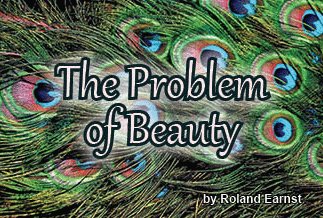
One of the challenges that skeptics use to argue against the existence of God is often called the problem of pain. The argument goes something like this: “Why would an all-powerful and loving God allow pain and suffering?” We have dealt with that problem before, including on our website whypain.org. However, there is a contrasting argument for the existence of God that some have called “the problem of beauty.”
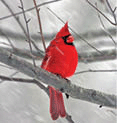
The problem of beauty asks the question: “How is it possible that evolution by natural selection could create such beauty in living things?” In other words, “How could natural selection acting on random mutations create beauty which seems to have no survival value?” Darwinian evolution operates on the survival of the fittest. However, survival of the fittest cannot explain many cases of beauty which seem to make animals less fit and thus less likely to survive.
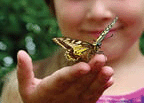
How can the seemingly simple process of natural selection explain all of the beauty in nature? Look around, and you will see beautiful designs that naturalistic evolution attempts to explain without a designer. Why are male cardinals so beautifully red? Why do butterflies have such exquisite designs and colors? Some animals display beautiful colors that make them more vulnerable to predators. A male bird may sing for an hour, announcing himself not only to prospective mates but also to predators. How can those beautiful features promote the survival of the fittest?

Lyrebirds, flowers, starfish, butterflies, and seashells all display beautiful features that cannot be explained as survival benefits. In some cases, they may be at least partially explained by mathematical principles. But then, where did the mathematical principles in our three-dimensional world originate except from the Creator of all things? Why does the nightingale sing beautiful songs to the darkness? Why do some lizards display colorful crests? How can colorblind cuttlefish change their colors at will not just to camouflage but to send messages to other cuttlefish or predators, or just to dazzle any observer? Why do flowers display not only beautiful colors but also soothing fragrances? The beauty of nature is visual, auditory, and even fragrant. Most of all, it is priceless.

A humpback whale's intricate and beautiful song lasts for half an hour. Does it have anything to contribute to the survival of these mammals? Well, in a way, it does. When human technology reached a point where the humpback's song could be heard and recorded in the 1960s, more people than the whale hunters got a chance to hear it. The exposure of that song to the general population of humans played a large part in the passage of laws preventing the slaughter of those animals. But that is evidence for human appreciation of beauty, not evolutionary natural selection. For those who suggest the male humpbacks use their songs to attract females, there is little to no evidence that the females are even paying attention.

No proponent of Darwinian evolution would suggest that humpback whales are even remotely related to nightingales, but those birds also sing long, complex, and beautiful songs. Rather than singing into the ocean, nightingales sing for hours into the night. As those small birds sit on a branch singing but not moving, they make themselves easy prey for predators. Instead of singing from twilight into the night, why do they not just be quiet and stay safe until morning? When scientists tape-recorded nightingales and slowed down the tape, lowering the pitch a couple of octaves, they discovered something very interesting. The result was that the nightingale's song sounded much like the song of a humpback whale. On the other hand, if you take the humpback whale song and speed it up while raising the pitch, it compares to a nightingale. Why should they be so much alike? Evolutionists like to call this sort of thing “convergent evolution.” I have another suggestion. Perhaps they got their music from the same original Composer.

Why do humans appreciate beauty? It brings us joy, eases our stress, and touches us deeply. Does a dog stop to admire a sunset, listen to beautiful music, or enjoy the beauty or fragrance of flowers? Do beautiful animals admire their own beauty? Do the birds sing because they love to hear music, or are they just doing what their Creator programmed them to do? Why did God design and program these animals in this way? Is it because he created us to enjoy beauty and gave us an earthly sample of the heavenly beauty he has planned for us? In other words, is beauty another evidence that God exists? I prefer to see the problem of beauty as the blessing of beauty.

Scientists talk about “emergent order,” referring to how the beauty of life emerged without any design or intelligent guidance. Instead, they say it was accomplished by a set of simple rules laid out originally by Charles Darwin and refined into what is now known as Neo-Darwinism. In his 1859 book On the Origin of Species, Darwin presented his principle of natural selection, but he realized that it could not explain the “selection” method used in all cases. Moreover, he was troubled by the excess beauty in nature and unnecessary frills and flourish, which he could not explain by natural selection. A year after that book was published, his frustration caused him to write, “The sight of a feather in a peacock's tail, whenever I gaze at it makes me sick.”
To cover those cases where natural selection cannot explain the beauty in nature, he introduced “sexual selection” in his 1871 book The Descent of Man, and Selection Related to Sex. Sexual selection involves the beauty often seen in male birds in general and peacocks in particular. According to Darwin's sexual selection theory, the reason for the beauty of the peacock's tail is that the peahens prefer such gaudy but impractical decorations. The same applies to many other species, such as bowerbirds or birds of paradise, where the males display striking colors or impressive actions to attract a mate.
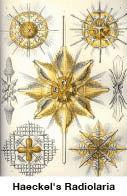
German zoologist and eugenicist Ernst Haeckel was also an artist who popularized Darwin by his artwork published in several books. His drawings depict the beauty he saw in even one-celled animals called Radiolaria. He attributed the beauty to natural selection and mathematical principles. Darwin's hypothesis enamored Haeckel so much that he went out of his way to promote it in books of drawings. However, his drawings sometimes show his bias for Darwinism. In The Natural History of Creation, he displayed one engraving comparing human embryos with embryos of pigs, sheep, and chickens, suggesting that the development of those embryos repeats the path of evolution. However, he manipulated his illustrations to prove his point. Other scientists later pointed out the flaws, and his dishonesty discredited his scientific credentials. Still, he promoted Darwinism believing that evolution was heading toward a grand achievement of design without a designer.
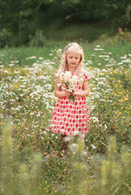
Physicist and Nobel laureate Steven Weinberg is an atheist who rejects belief in God because of the problem of pain. He explains that in his book Dreams of a Final Theory. However, he cannot explain the problem of beauty. He made the understatement of the century when he wrote, “I have to admit that sometimes nature seems more beautiful than strictly necessary.” Evolutionary biologist and atheist Richard Dawkins, writing in his book Climbing Mount Improbable, told about when he was driving through the countryside with his young daughter. The girl was excited about seeing “pretty” wildflowers. Dawkins asked his daughter what she thought was the purpose of wildflowers. She replied, “To make the world pretty, and to help the bees make honey for us.” Dawkins said he was sorry that he “had to tell her that it wasn't true.” According to Dawkins, biology is the study of things that appear to be designed for a purpose, but his atheism forces him to argue that there is no purpose.
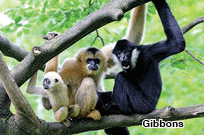
There are many examples of the problem of beauty. Various species sing songs and perform dances that go beyond what survival would require. Gibbons sing duets, and birds of paradise display their beauty with song and dance. Bower birds go to excess extremes to create works of art. (see the Dandy Designs article on page 24). Birds known as whydahs have extravagant and impractical tails that are longer than their bodies. Like the peacock's tail, these attributes seem inefficient and not a method to adapt to the environment.

Parrots come in a variety of dazzling colors that do not seem to be for the purpose of adapting to the environment. Are these colors for survival of the fittest or what David Rothenberg, a philosopher at the New Jersey Institute of Technology, calls “survival of the beautiful”?
Humans are obsessed with beauty. We use cosmetics and clothing trying to make ourselves more beautiful. We seek to create beauty in music and art, and we continually long for something even more beautiful. What is the purpose of beauty? It is not to provide protection or solve problems. The purpose is to bring joy, peace, and meaning to life. However, as we seek beauty, we long for something even more beautiful. We strive to create it, but we also desire to find it in nature.
The prophet Isaiah in a vision, saw God's throne room where one seraph cried out, “Holy, holy, holy is the Lord of hosts: the whole earth is full of his glory” (Isaiah 6:3). God's glory is displayed in the beauty we see on this planet. The curse of sin has marred that beauty, but it still peaks through. It reminds us of the Creator of “every good and perfect gift” (James 1:17). Theologian N. T. Wright asked the question that we all face at some time, “If the earth is full of God's glory, why is it also so full of pain and anguish and screaming and despair?” That is the problem of pain, but I think we can see a glimpse of the answer in the so-called problem of beauty.

I suggest that humans appreciate and desire beauty because God created us in his image. God creates beauty in the world around us to give us a sample of what is possible. When we see beauty, we long for more because there always seem to be imperfections in the beauty we see here. Peacocks die. Colorful fall leaves turn brown and fall to the ground. The beauty of a sunset is fleeting. We long for more. We want to know what more God has in store for us.
The Apostle John saw a vision of what God has waiting for those who accept his gift of eternal life. In Revelation chapters 21 and 22, he struggled to describe it in terms of the familiar, such as gold, pearls, and jewels, but he knew those words were inadequate. In the beauty around us, we see a glimpse of the glory of God's beauty. We long for the revelation of the pure beauty of God's kingdom. As we struggle to answer the problem of pain, perhaps the answer is right before our eyes. The problem of beauty is only a hint, a clue, a sample of the ultimate beauty. I cannot wait to see the real thing.
Picture credits:
© val lawless. Image from big stock.com
© william wyrick. Image from big stock.com
© OLEKSII KRIACHKO. Image from big stock.com
https://en.wikipedia.org/wiki/File:Superb_lyrbird_in_scrub.jpg
© desertrosestudios. Image from big stock.com
© Vlasto Opatovsky. Image from big stock.com
© Remains. Image from big stock.com
© Tasha_Bubo. Image from big stock.com
https://commons.wikimedia.org/wiki/File:Haeckel_Acanthometra.jpg.
© g215; Image from big stock.com
© Anolis. Image from big stock.com
https://en.wikipedia.org/wiki/Long-tailed_paradise_whydah#/media/File:Long-tailed_paradise-whydah_(Vidua_paradisaea)_male.jpg;
© Roman1030. Image from big stock.com
Scripture links/references are from BibleGateway.com. Unhighlighted scriptures can be looked up at their website.
